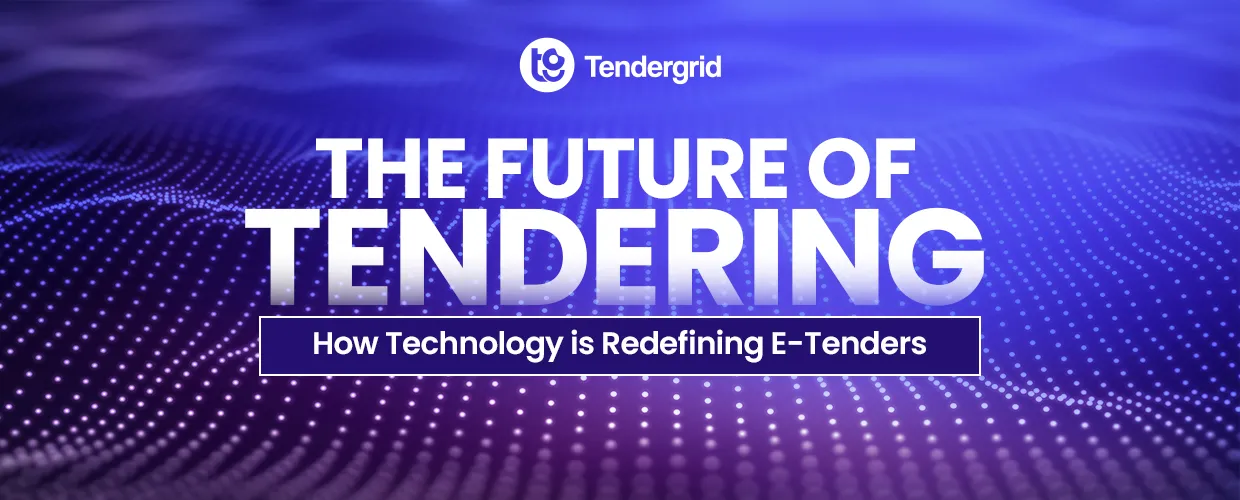The world is undergoing a profound transformation, especially in the procurement sector. As organizations look towards streamlining operations, reducing costs, and increasing transparency, digital transformation is becoming a global imperative. One of the most significant development in procurement is the spread of eTendering trends across industries and governments worldwide, which has gained rapid momentum. Moving from traditional paper-based tendering processes to digital platforms has unlocked a world of benefits, including enhanced efficiency, increased transparency, and a more competitive environment. With the rise of the eTenders portal in India and globally, eProcurement services are reshaping the tendering landscape and helping businesses and governments keep pace with the future.
This blog discusses the emerging trends in eTendering and technological innovations that change the face of procurement and its future in global eProcurement. Let's explore more about this interesting evolution:
The Global Shift to E-Tendering
The global trend has witnessed the shift towards electronic tendering (eTendering) across the world, reshaping the procurement process among the nations. Governments and industries increasingly recognize the advantage of switching from paper to eTendering trends. By reducing the cost, in addition to increasing accessibility through enhanced transparency, eProcurement services minimizes errors and delays during automation processes such as publication, submission, evaluation, and awarding of contracts.
Regions such as Europe, North America, and Asia have led the way regarding the adoption of eTendering solutions. For instance, the European Union welcomes eProcurement to increase convenience in cross-border procurement. The United States and Canada, have greatly advanced e-procurement, which has been particularly prevalent among the public sectors.
Asia is also not lagging, countries like India are modernizing government procurement through digital platforms, such as Tender Grid. An example of how online tendering has helped improve efficiency and competition is well seen in India's Government e-marketplace (GeM).
Cutting-Edge Technologies Redefining E-Tendering
The integration of advanced technologies is significantly transforming the way eTendering platforms function, enhancing both efficiency and security. Several cutting-edge technologies are driving this transformation:
- Artificial Intelligence (AI) and Machine Learning: Artificial intelligence and machine learning will transform the tendering process with the ability to process huge data, predict market trends, and detect potential fraudulent activities. Through AI, it can track patterns in bid evaluations indicating bias or unfair practices and enable procurement officers to receive instant alerts. This leads to more objective, data-driven decision-making, ensuring the best bids are selected with no human error or bias.
- Blockchain Technology: Integration of blockchain technology is a growing feature of eTendering systems to provide for greater transparency and security. The decentralized structure of blockchain implies that tender data cannot be amended or changed in any form, while remaining fully traceable. Thus, the need for blockchain technology arises primarily in cross-border or high-value tenders for verifying documents tracking transactions, or ensuring contracts by agreements reached by the parties. It significantly enhances trust and transparency in procurement.
- Cloud-Based Solutions: Cloud technology gives eTendering systems the scalability, flexibility, and cost-effectiveness that a company or government agency may desire. Access from any device at any location makes procurement easy and accessible for businesses as well as government agencies. Moreover, it reduces the costs associated with expensive infrastructure while giving robust data management. Scalability is very simple and easy in cloud-based systems, which can manage big as well as small projects for organizations of all sizes.
- Robotic Process Automation (RPA): RPA automates repetitive tasks like document verification and bid evaluation, reducing human error and speeding up processes. This cuts down the administrative costs and accelerates the entire tendering workflow.
- Data Analytics and Big Data: Big data analytics would allow organizations to identify trends, track supplier performance, and make informed decisions that further add efficiency and effectiveness to the eTendering process. Predictive analytics can inform them of opportunities to optimize their procurement strategies and uncover potential cost savings.
Top E-Tendering Trends Shaping the Future
Several key trends shape the future of eTendering, transforming how procurements are conducted worldwide:
-
Mobile and Cloud Adoption: The increasing reliance on mobile devices and cloud technology is making eTendering accessible. Cloud-based platforms enable organizations to manage tenders from anywhere, at any time, empowering businesses and government entities to respond to procurement opportunities on the go.
-
Green Procurement and Sustainability: Sustainability is fast becoming an essential element in tender evaluations. Governments and organizations are giving importance to environmental and social impacts, and hence, eTendering platforms include tools that measure the sustainability practices of suppliers. This involves their carbon footprint, waste management, and labor standards.
-
Smart Contracts and Automation: This revolutionizes contract management. The smart contracts automatically implement conditions in the terms, reducing delay and disputes, leading to more efficient, mistake-free contract execution.
-
Cross Border Tendering and Supplier Diversity: eTendering is opening up an avenue for access to the worldwide suppliers pool, and so access for businesses and government tends and procurements from a variety of suppliers. Besides economies in cost, the phenomenon aids in supplier diversity in building a more inclusive nature for procurement.
-
Real-Time Monitoring of Tender Status: This enhances transparency and communication as both the bids of the supplier and the completion of all stages by the authorities can be monitored in real-time.
Challenges Related to Technology in Global E-Tendering
Although eTendering is widely adopted, challenges persist. To sustain its growth, these challenges must be addressed in global eTendering.
-
Digital Divide and Accessibility: Access to technology for eTendering is not uniform across regions. In some developing markets, infrastructure constraints and digital illiteracy act as major barriers. The problem is being solved with the help of mobile-friendly platforms and user-friendly designs that are making accessibility easy.
-
Cybersecurity Risks: With the increase in digital transactions, cybersecurity has become a pressing concern. Sensitive data such as pricing and supplier information must be protected from potential cyber threats. Solutions like encryption, multi-factor authentication, and blockchain technology are being implemented to safeguard tender data and maintain its integrity.
-
Integration with Legacy Systems: Most organizations are still using legacy procurement systems, making it hard to integrate eTendering solutions. Modern eProcurement services offer cloud-based solutions that are compatible with existing systems, making integration and data migration easier.
How Tender Grid is Paving the Way for Global E-Tendering
Tender Grid is taking the lead in global eTendering with the most powerful functionalities that transform the process of procurement. By linking tendering opportunities on global levels, Tender Grid opens businesses access to cross-border tenders and greater opportunities for international collaboration.
Simple design makes it easy enough for both big and smaller businesses to use while smart AI-driven insights assist their users to make better decisions informed by data. Even beyond this, Tender Grid's enhanced security measures will ensure that all tender data is encrypted and protected in a secured bid feature.
The Role of E-Tendering Portals in Global Procurement
E-tendering portals have been critical in the transformation of the global procurement landscape. E-tendering portals have helped in speeding up the processes of procurement, making it more transparent, and cost-effective.
- Enhanced Transparency & Accountability: The eTendering portals have reduced the risk of fraud and corruption by digitizing the procurement process. The tendering process is transparent, and stakeholders can verify that the right suppliers are being selected, thus making it accountable at every stage.
- Efficiency & Cost-Effectiveness: Digitization in tendering has decreased administrative costs and time delays drastically, hence saving businesses money and time while focusing on core activities.
- Global Market Reach: E-tendering platforms provide small businesses in developing countries with access to global opportunities, enabling them to compete for tenders that were previously limited to large domestic firms.
- Cross-border Collaboration: E-tendering platforms have made cross-border collaborations easier. Businesses and governments can choose suppliers from the global pool, which makes a market more diversified and competitive.
Conclusion
The future of eTendering is bright, with technological innovations like AI, blockchain, and cloud-based solutions reshaping the procurement landscape. As businesses and governments strive to remain competitive, adopting secure, scalable, and efficient eProcurement solutions will be essential. Tender Grid stands as a leading example of how eTendering platforms can drive efficiency, transparency, and global market opportunities.
Businesses and organizations should capitalize on the benefits of eTendering in this digital age. By doing so they will be able to stay ahead of the competition while making their procurement processes clear, efficient, and cost-effective.

